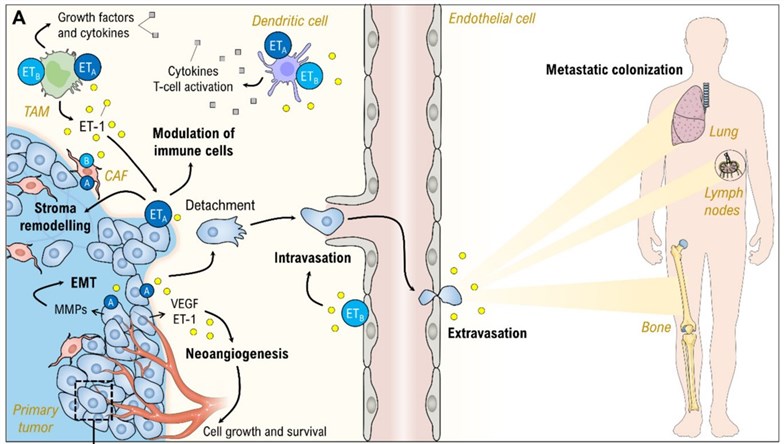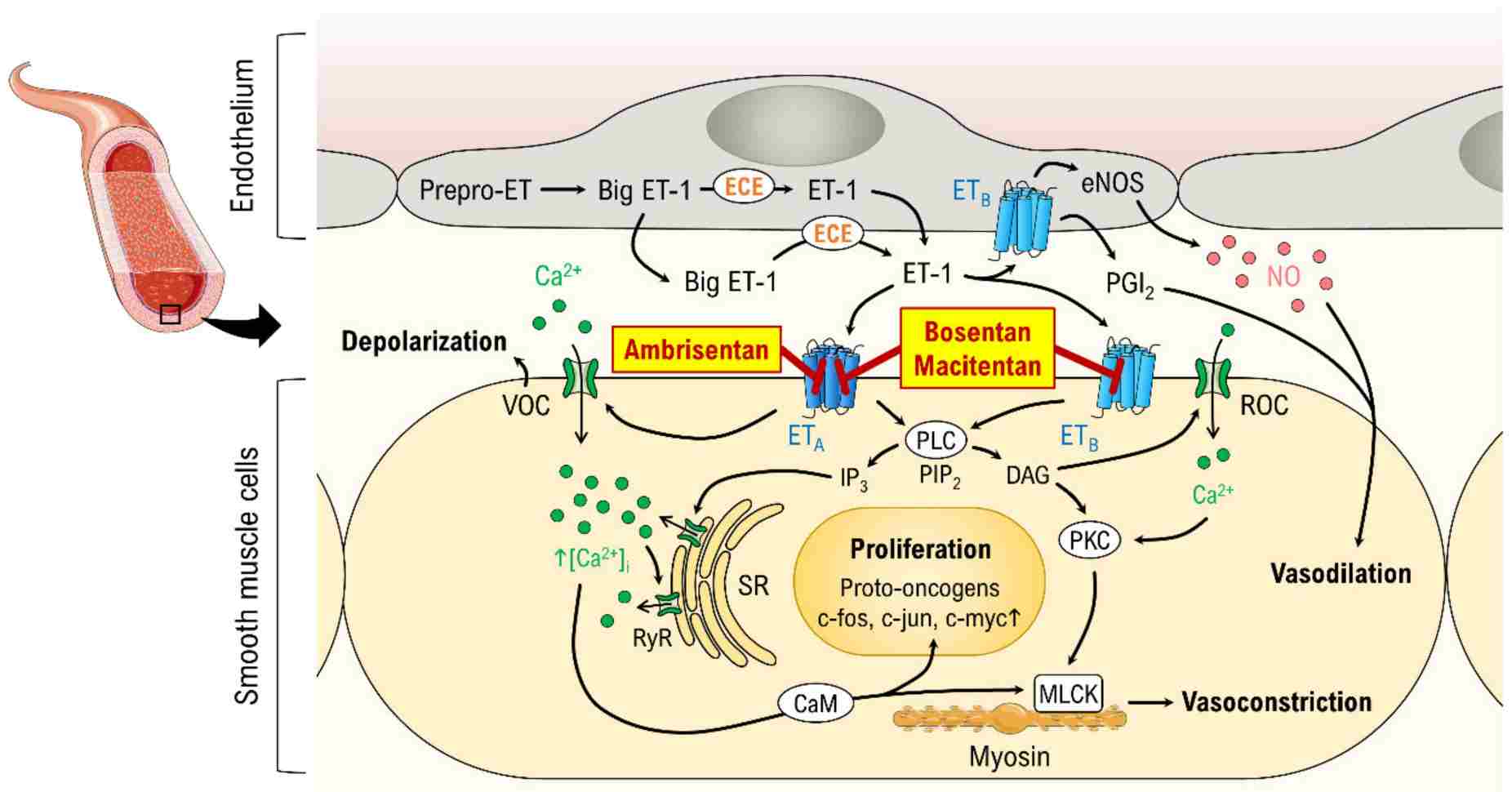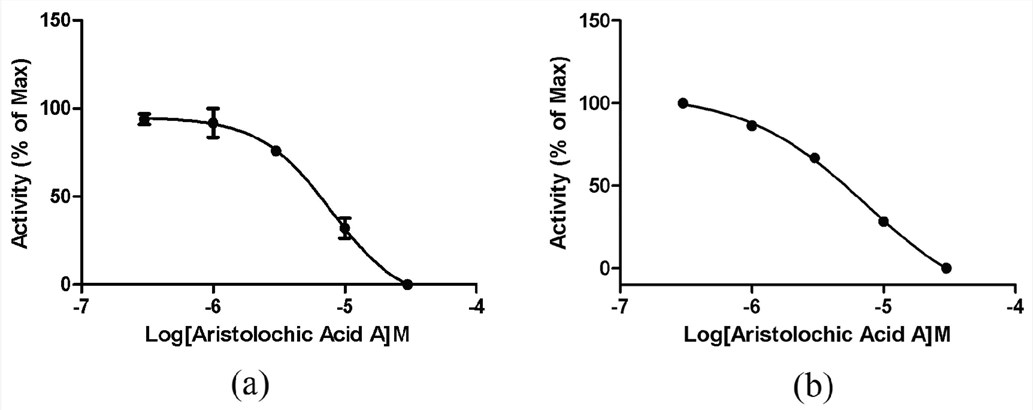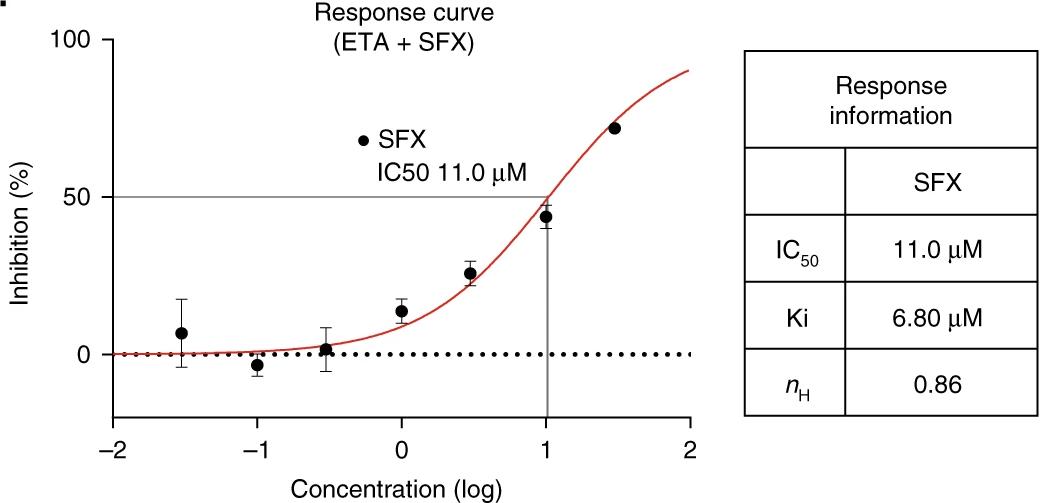Hi-Affi™ In Vitro Cell based Endothelin Receptor Functional Assay Service
Endothelin Receptors: Why They Matter
Endothelin receptors involve two subtypes: ETA and ETB receptors, and both of them belong to the class A GPCRs, which are often used as targets in drug development. They are triggered by three different forms of endothelin (ET-1, ET-2, and ET-3) and may be found throughout all tissues, especially in blood vessels. Consistent with the physiological role of endothelins as ubiquitous endothelium-derived vasoactive peptides, endothelin receptors play an essential part in the maintenance of vascular tone. Therefore, endothelin receptors have the potential to be drug targets in cardiovascular disease therapy.
 Fig.1 Involvement of ET-1 (yellow circles) in cancer progression and metastasis.1
Fig.1 Involvement of ET-1 (yellow circles) in cancer progression and metastasis.1
Our Hi-Affi™ In Vitro Cell-based Endothelin Receptor Functional Assay Service
Cell-based in vitro assay has been widely employed to aid medicinal chemistry efforts in identifying structurally varied compounds as prospective therapeutic candidates. This method features high sensitivity and high reproducibility. Creative Biolabs combines this assay with GPCR functional assay and has successfully developed a Hi-Affi™ in vitro cell-based endothelin receptor functional assay service.
Our Hi-Affi™ in vitro cell-based endothelin receptor functional assay service is carried out by assessing the change of cellular cAMP concentration and calcium flow triggered by the response of ligands and endothelin receptors, which is capable of assaying compounds and analyze their ability to modulate endothelin receptors. Throughout the process, Creative Biolabs provides a full range of customized services from experiment design to data verification, to aid global customers' projects.
 Fig.2 The canonical pathway of ET-1.1
Fig.2 The canonical pathway of ET-1.1
Benefit of Hi-Affi™ In Vitro Cell-based Endothelin Receptors Functional Assay Service
 Fig.3 Features of our Hi-Affi™ in vitro cell-based endothelin receptors functional assay service.
Fig.3 Features of our Hi-Affi™ in vitro cell-based endothelin receptors functional assay service.
Case Study
 Fig.4 Dose-response curves for aristolochic acid A using calcium influx assay.2
Fig.4 Dose-response curves for aristolochic acid A using calcium influx assay.2
Summary: Calcium mobilization within recombinant cells (human embryonic kidney (HEK)/ETAR and HEK/ETBR cells) was measured at 10 M for the six compounds selected through virtual screening for their capacity to antagonize the ETA/ETB receptor.
Results: The finding shows only aristolochic acid A was verified to be a validated success with an inhibition rate greater than fifty percent among the six compounds. The IC50 values for aristolochic acid A inhibiting ETAR and ETBR were 7.91 and 7.7 μM, respectively.
Summary: In order to determine a specific protein target of antibiotics in cancer cells, researchers employed an in silico method based on the Similarity Ensemble Approach (SEA). Based on the data obtained from the BindingDB, SEA has identified four proteins that could potentially serve as target candidates.
Results: The findings showed that only the antibody that recognized ETA produced a signal in elution fractions from the membrane fraction, but not in the lysate. Following a radioactive binding experiment, an IC50 value of 11.0 M antibiotics was determined.
 Fig.5 Dose-response curve showing the suppression of human ETA receptor binding by 125I-ET1.3
Fig.5 Dose-response curve showing the suppression of human ETA receptor binding by 125I-ET1.3
As an industry leader, Creative Biolabs is dedicated to providing each client with state-of-the-art service and innovative approaches in the research of GPCR function. At the same time, we provide related assays to aid in the identification of GPCR function.
For more about our Hi-Affi™ in vitro cell-based endothelin receptor functional assay service, please don't hesitate to tell us about your projects. Looking forward to being a partner with global customers.
References
-
Enevoldsen, Frederik C., et al. "Endothelin receptor antagonists: status quo and future perspectives for targeted therapy." Journal of Clinical Medicine 9.3 (2020): 824.
Distributed under Open Access License CC BY 4.0. The original image Figure 3 was modified by extracting and using part A, and the title was changed to "Involvement of ET-1 (yellow circles) in cancer progression and metastasis". The original image Figure 1 was not modified. -
Wang, Xing, et al. "Discovery of dual ETA/ETB receptor antagonists from traditional Chinese herbs through in silico and in vitro screening." International Journal of Molecular Sciences 17.3 (2016): 389.
Distributed under Open Access License CC BY 4.0, without modification. -
Im, Eun-Ju, et al. "Sulfisoxazole inhibits the secretion of small extracellular vesicles by targeting the endothelin receptor A." Nature Communications 10.1 (2019): 1387.
Distributed under Open Access License CC BY 4.0. The original image was modified by extracting and using part i, and the title was changed to "Dose-response curve showing the suppression of human ETA receptor binding by 125I-ET1".
For Research Use Only.
